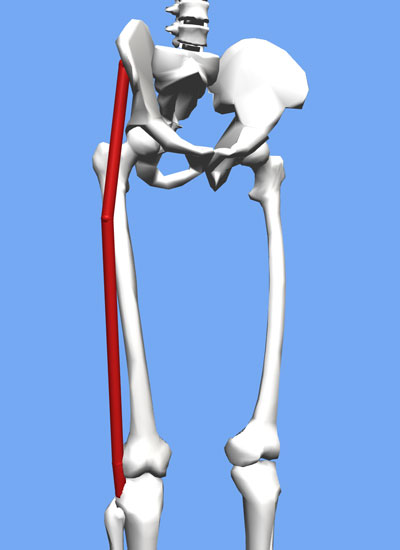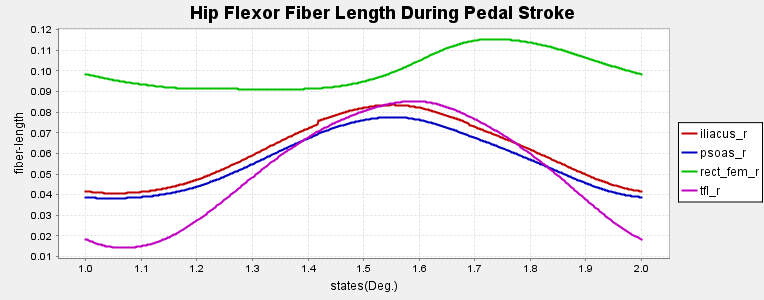What Causes Hip Flexor Pain While Cycling?
Do your hip flexors hurt when you ride your bike? Hip flexor pain is a common problem with cycling because we flex our hip during every pedal stroke. Let's look at the muscles that can flex the hip and how they fit into the pedal stroke.





Firstly, hip flexion is the action of rotating the femur towards the front of the pelvis. This movement is in opposition to the much stronger hip extension, which uses the glutes to rotate the femur towards the backside of the pelvis. Each hip flexor is unique and interesting and they all serve a separate purpose in addition to hip flexion. Refer to the image gallery above for a visual representation of the muscles.
The Muscles Involved in Hip Flexion
Iliacus
The iliacus connects the 'fin' (iliac crest) of the hip to the femur and extends vertically along the front of the hip. When this muscle is engaged and shortened, the femur rotates directly upward toward the front of the pelvis. When we think of hip flexor pain with cycling, the iliacus is a major consideration because of it's vertical position at the front of the hip.
Psoas
The psoas follows a similar line to the iliacus, but instead of connecting to the iliac crest, it connects to the bottom of the spine. For better or worse, this muscle links our femur and spine together. Dysfunction in this area can be a common cause of low back pain. The psoas is notorious for being difficult to stretch and work with because it is relatively deep in the body and passes through from front to back. Although many researchers claim that the psoas is the only muscle that can lift the femur above 90 degrees in hip flexion, this claim has recently been disputed by researchers with no definitive answer from either side.
Sartorius
The sartorius is an interesting muscle that connects below the knee on the inside and wraps diagonally across the front of the leg. At the hip, it connects to the anterior superior iliac spine (ASIS), the bony point that protrudes out of the front of our hip. As you probably guessed, engaging this muscle will cause the hip to flex, but it will also cause the femur to rotate.
Rectus Femoris
The rectus femoris connect to the hip and below the knee right down the center of the femur. Typically, rectus femoris engagement induces hip flexion if the knee joint angle does not change. In the case of cycling, because of the large knee movement during cycling, rectus femoris length and engagement is normally driven by knee movement patterns.
Tensor Faciae Latae (TFL)
The TFL connects the directly to the IT band and down the outside of the leg. As pictured, the TFL connects from the pelvis to just below the knee joint. In reality, the TFL only extends to the kink about a third of the way down, the rest is tendon. Athletes will typically try to roll out their IT bands, but tendons don't normally change length significantly. They should be focusing on reducing dysfunction in their TFL. Proper TFL length will reduce the tension on the IT band.
Hip Flexor Engagement in the Cycling Pedal Stroke

It's worth noting that all of the TFL, rectus femoris, and sartorius connect below the knee. As a result, when the knee is flexed or extended, their length changes. Above is a diagram of the fiber-length (corollary to muscle length) of these hip flexors throughout the pedal stroke. In this diagram, the x-axis is one pedal stroke starting at top dead center (12 o'clock) and rotating through the entire pedal stroke back to 12 o'clock. The center of the graph is at bottom dead center (6 o'clock). As you can see, the fiber-length changes in the iliacus and psoas follow a pattern matching the hip joint movement. The TFL, rectus femoris, and sartorius have a different movement pattern due to being two-joint muscles. The sartorius is included on a separate plot because its fiber length is significantly longer than any of the other hip flexors.

If you are having hip flexor pain while cycling, it may be advantageous to determine what area of the pedal stroke is the issue. Do you have pain on the upstroke, downstroke, all the time? A decrease in muscle fiber length is associated with engagement of that muscle, so match up your pain position with the graphs above to get a better idea of the problem muscle.
Hip Flexor Power Production In Cycling
Recent studies have shown that hip flexion accounts for some small amount of the total power produced during cycling. One study on joint specific pedaling power suggests that only ~14% of power produced comes from hip flexion. With that being said, it's common for cyclists to use their hip flexors to lift the weight of the pedal on the backside of the pedal stroke. This lifting of the leg allows for the opposite leg's propulsion to push the cyclist forward rather than to lift the backside leg. Although this lifting does not produce much power, it may be fatiguing on the hip flexors, especially pedal stroke after pedal stroke.
The hip flexor's main purpose in cycling is to allow cyclists to efficiently decrease the backside weight. Our hip flexors can also help to effectively produce hip extension power. The glutes are the direct antagonist to the hip flexors. We know the glutes can account for some ~50%+ of the power produced in the pedals stroke. There is a phenomenon called reciprocal inhibition where engagement of one muscle causes the antagonist muscle to relax, allowing the engaged muscle to fully produce force. When our hip flexors function properly, we can effectively inhibit them to maximize glute force.
Hip Flexor Mobility and Pain When Cycling
On top of this, flexibility is essential to cycling. Good flexibility allows riders to get into an aggressive position and maintain that position for hours at a time. Improper hip flexor mobility can limit the position a cyclist can get into. Even worse, if we force ourselves into an uncomfortable position, it can cause pain in our lower back or hips. One way to reduce hip flexor pain when cycling is to maintain good hip flexor mobility and the best way to maintain hip flexor mobility is through stretching. Although everyone thinks they know how to stretch their hip flexors, in reality, sitting in the 90/90 position is not sufficient to induce a stretch.
Athletes should look to induced posterior pelvic tilt by rotating their pelvis down and backwards to lift the origins (connections on the pelvis) of the hip flexors away from the insertions (connections on the femur). In order to stretch the hip flexors that connect below the knee, introduce a quad stretch, by pulling the ankle up to towards the butt, in addition to the hip flexor stretch. This can extend the TFL, sartorius, and rectus femoris such that they engage in a stretch.
As with all stretches, be careful and you shouldn't be trying to pull the joint out of the socket! Just get in position and lightly push to feel a slight pulling along the muscle you are attempting to stretch. As a word of warning, it can be very difficult to stretch the hip flexors. Keep at it and make sure your pelvis is square and you aren't leaning to the side.